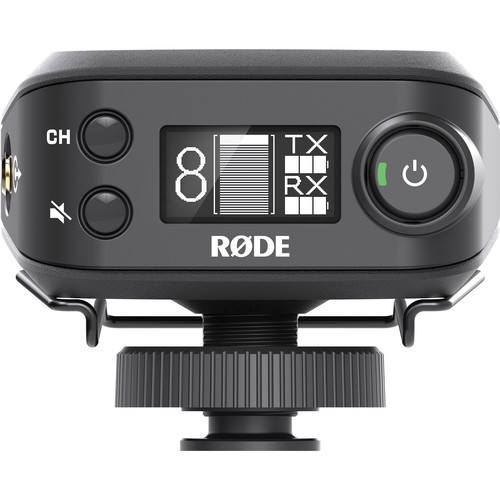Consumer vs Pro Wireless Microphone Systems
Why do professional level wireless microphone systems cost so much? Do they just have audio quality that is that much better? Or are there other features that pros need that enthusiast filmmakers don’t need? What am I missing if I go for one of the consumer/prosumer wireless systems?
In this episode we explore these questions by talking about 3 wireless microphone systems I use: RODELink, Sennheiser G3 (and now G4), and the Audio Limited A10 system. We clarify the important differences so you can understand when a consumer grade wireless system is everything you need for your projects and when it might make sense to rent or buy a pro-level wireless system.
Links to gear discussed and used to shoot this episode:
RODELink Filmmaker Kit - Good digital wireless consumer/prosumer system - Been a useful part of my kit for 3 years.
Sennheiser G4 112P - Good analogue prosumer wireless system (If you buy this, be sure to choose the block that is legal to use in your locality. Buy through a dealer that can help you if you’re not sure. Also, it does not appear that the older G3 is retailing for less at this point. I’d go for the G4. The technical differences are negligible):
Audio Limited A10 Dual Channel Receiver - Pro level all-digital wireless system for lavalier and boom microphones. This receiver supports two channels (i.e., two separate transmitters can transmit to this receiver which then sends two separate audio channels to your audio mixer/recorder).
Audio Limited A10 Transmitter - body pack transmitter for the all-digital A10 wireless microphone system. This supports lavalier microphones plus boom microphones, even those needing phantom power (via 3-pin lemo to XLR adapter cable)
Sennheiser MKH 8050 Microphone - used to record this entire episode
Aputure COB 120t - This is the light I used as a key in the talking head clips
Aputure Light Dome Soft Box - Used to soften the key light
Lupo DayLED Fresnel Light with Barn Doors - Used for the “rim/hair” light
650, 1000, & 2000 in daylight, tungsten, or bi-color
Blackmagic design Ursa Mini Pro Cinema Camera - used for the talking head shots in this episode
Sigma ART 24-70mm f/2.8 OS Lens (Canon EF Mount)
Panasonic GH5 - Used for some of the product shots
Panasonic 12-35mm f/2.8 OIS Lens - incredibly versatile lens that is on the GH5 most of the time
Copyright 2018 by Curtis Judd
Music - MzA by Cary Judd, used with permission
Good Budget Wireless Lavalier: Azden PRO-XD
One of the most common questions I've received from YouTubers: "I'm going to start a prank channel at YouTube. What wireless microphone should I get?"
I've never done a single prank video so I don't pretend to be a master at understanding all the nuances of quality prank videos, but Azden was kind enough to send me a copy of their PRO-XD Digital Wireless Lavalier system to review.
After working with it for about three weeks, here’s the review. Overall, this is a great budget digital wireless lavalier system priced at $200 USD. While it isn’t as robust as more expensive wireless systems, this system does have a lot going for it and is very good value for money.
The upside? Great performance in terms of keeping a signal, battery life, and producing solid, quality audio. Oh, and the price: $199 USD. This is the best sub $200 wireless lavalier system I've used.
The downside? The included lavalier microphone isn't amazing, but you can clean up the audio in post or replace it with another 3.5mm TRRS lavalier microphone.
Would I opt for this over the RODELink wireless lavalier kit? No, not if I had the budget for the RODELink (see our review here) which is twice the price. But if you're operating on a tight budget, the PRO-XD is definitely worth a look.
Azden PRO-XD Digital Wireless Lavalier Initial Test & Moving Help Sessions
Azden sent over a copy of their PRO-XD wireless lavalier system and in this episode we're doing an initial sample so that you can hear what it sounds like after routine, mild post processing (mild noise reduction, mild compression, loudness normalize to -16LUFS and true peak limit to -1.5dB true peak). We'll have a quick review later this week.
Someone already asked, do you like this or the RODELink better? If money was not a factor, of course I like RODELink more but if money is a factor, and it usually is, the PRO-XD is half the price of RODELink.
The Azden kit has a few unique features and one of the biggest is the size of the transmitter and receiver - they're tiny. They also have in-build lithium-ion batteries which can be charged via micro USB cable and the wireless works as well as RODELink and Sennheiser AVX in terms of keeping a signal in my tests so far. Audio quality is good, though not as good as AVX. It also includes an adapter so you can record to mobile devices which is a nice touch as well.
Seems like a good kit if you're on a tight budget.
And as for the help sessions, we've received feedback that it would be better if we would move those to a different channel. I agree, they're different enough (i.e., an hour in length, Q&A style instead of focused topic) that they should probably be somewhere else. So we’ll post them here.
Sennheiser AVX Digital Wireless Microphone System Review
So here it is, finally after 4 weeks of working with it; my review of the Sennheiser AVX wireless microphone system.
Sennheiser recently introduced their new digital wireless system called AVX. There are various kits available and in this episode I used the kit with the body pack transmitter, receiver, and MKE2 lavalier microphone (their higher-end pro lavalier microphone). We looked at various aspects of the AVX system including how well it does in terms of outdoor distance, dynamic range which Sennheiser touts as preventing clipping distortion when your talent suddenly gets very loud, sound quality of the MKE2 lavalier microphone, latency, rejection of RF and WiFi interference, battery life, and others. Let’s see how it does!
Sennheiser AVX Dynamic Range and Outdoor Distance Tests
https://youtu.be/uUSd_ulXdno Sennheiser recently introduced their new digital wireless system called the Sennheiser AVX. There are various kits available and in this episode I used the kit with the transmitter, receiver, and MKE2 lavalier microphone (their higher-end pro lavalier microphone).
We did a few tests to see how well the AVX does in terms of outdoor distance (keeping its signal without dropping out), and the dynamic range feature Sennheiser touts as preventing clipping and distortion when the sound gets much louder.
The outdoor distance test was as expected: Solid up to 50 meters, and my first dropout occurred at around 75 meters. You need to pretty much be in line-of-sight to get a solid signal at 50 meters. I never shoot this way, but it is good to know the limits of one's tools.
The dynamic range feature was way more impressive than I expected. It really works and sounds good! I feared it might be like Automatic Gain Control like they include in many of the DSLRs and that AGC feature is awful in those cameras. It stupidly pushes the gain up through the roof during silent sequences and that just makes an unbearably noisy mess of the audio. But on the AVX, it sounds very transparent and clean. I really like it!
Final review should be here later this week. Let me know if there are other things you'd like me to test before I have to send it back to my friends at B&H Photo.
RODELink News Shooter Kit Pricing
RODE's new RODELink News Shooter kit has gone on pre-order over at B&H Photo and it looks like pricing will be $499 per kit. That strikes me as a fair price for the quality and value we're accustomed to seeing from RODE.
Looking forward to getting a copy for review some time in November.
RODELink Wireless Lavalier System Review
It's been a lot of work, but here it is, finally: My review of the RODELink Filmmaker Wireless Kit. What do I think overall? This is a good balance of quality for the price (launched at $399 USD).
Pros:
- Digital signal does not drop when working within 50 meters in any of the tests I did, even outdoors and in WiFi heavy offices (because WiFi uses the same frequency in many cases).
- Battery life - lasted 7 hours and 10 minutes on a set of eneloop AA batteries (and this set is about 3.5 years old and has had a lot of use in photo flash units and audio recorders). This is much better than I expected.
- Very simple setup
- Can use up to 8 kits simultaneously
- Good audio quality
- No annoying external antennas
- No latency issues so audio stays perfectly in sync with the video captured by your camera
Cons:
- Plastic body and receiver packs (though it is good quality plastic, it is still plastic)
- Body and receiver packs are a little larger than most others in a similar price range (Perhaps this is the tradeoff for no antennas). Not a problem when mounted on someone's belt behind them but potentially a little more tricky for mounting on brides
One thing that took me a while to figure out is that the mic that comes with the kit sounds a fair bit better when hidden under the shirt of your talent. It seems that it really was made to be hidden vs worn on the outside of clothes. That would explain why they call it a filmmaker kit and not an ENG kit. I just use the RODE Invisilav to make it super simple to mount the mic under the talent's shirt.
Also, it can be used with any mic with a 3.5mm mini stereo jack (TRS) like the RODE VideoMic Pro. So you can even have a wireless shotgun microphone!
RODELink with Multiple Transmitters?
The question has come up several times now, "Can you transmit from two mics and transmitters to a single receiver with RODELink?"
Short answer: No.
There are wireless systems where you can transmit from multiple body packs to a single receiver, but the receivers are large, usually metal case deals that would not be fit for rigging on a camera and they usually include an AC to DC power brick adapter. These are really designed for live sound and concerts.
The RODELink, just like all the other wireless systems designed for film, video, and ENG are designed to work in the field without AC power and to be small enough to rig on a camera if you're using one or two units.
So, if you're shooting an interview, you will need two kits, each with a transmitter and receiver. But then the question becomes, how do you get the signal from two receivers into your camera that only has one 3.5mm TRS mic input? (often these are referred to as stereo minijack inputs - same thing)
There are probably a lot of other ways, but I use my Tascam DR-60DmkII instead of my camera. But even this only has one 3.5mm input. Not to worry, RODE offers a 3.5mm to XLR adapter for this very purpose! They call it the VXLR adapter and it allows me to plug two RODELink receivers into the two XLR inputs on the DR-60D.
I usually just record the audio with the Tascam and then sync the sound with the video in post. But some people hate doing that and are willing to sacrifice 24 bit audio for 16 bit camera audio. And I get it, there's plenty of debate out there as to whether 24 bit is all that critical. For the record, I always record 24 bit. I'm not saying you have to but here's my reasoning: It uses up very little space relative to high bit-rate video and gives me more latitude to clean things up in post. And for those that argue it doesn't make a difference in post, I'd love to see a specific, compelling example you can show to prove that. Also, syncing in post is really easy. If you're doing a ton of clips, yeah, that's harder and maybe in that case you need Pluraleyes (software from Red Giant that automatically syncs all your audio and video clips from a shoot) to do that for you.
But if you just cannot bother with all that, you could just run the signal out of the Tascam's output to the camera's mic input and then you're all set!
Someone also asked if they could just use a 3.5mm splitter to get the signal from the two receivers into the camera. In theory that should be possible. Of course you're back to using the camera's preamp (which is pretty poor quality with most cameras that have 3.5mm inputs) and 16 bit audio for most cameras. So, your results may be less than optimal.
If this is your first exposure to the RODELink wireless mic system, we've done a couple of video episodes on it so far that you might find interesting:
RODELink Distance and Interference Tests
One of my biggest concerns when I first heard about the RODELink wireless lavalier system was how well they would hold up in environments with a lot of potential interference, like corporate offices with lots of wifi network activity. Also, I was curious to learn how well it would perform when you use two kits simultaneously. So in this episode we put the RODELink to the test in two scenarios: First, we have our actors walk around a corporate office away from the receiver unit until we experienced the signal dropping. We also recorded a mock interview with two kits in a wifi heavy office building. Let’s see how RODELink held up!
(Pretty well, it turns out)
RODELink Wireless Audio: Initial Test & Overview
https://youtu.be/o6P59ZxpANI You voted that you wanted a review of the RØDELink wireless audio system a few months back and here is the initial test as I put together the full review over the next few weeks. So far, this system looks like a nice fit for enthusiasts and pros working with small crews. One thing that really impressed me was that the Filmmaker kit comes with the RØDE Lavalier microphone which on its own is normally a $250 US microphone which is more than half the price of the filmmaker kit. In my initial tests I have not experienced a single drop out though admittedly, I haven’t yet stress tested it by taking two units into a heavy wifi environment (that’ll come in the full review). So I hope this whets your appetite while I work on the full review.
My initial impression is that the RODELink Filmmakers Kit hits a very nice combination of price to build and audio quality. We're planning some stress tests (throw a bunch of wifi at it and record with two transmitters and receivers in an interview, distance) and should have the full review up in another couple of weeks. Let me know if you have any questions you would like answered specifically!








 Support Me on Ko-fi
Support Me on Ko-fi
